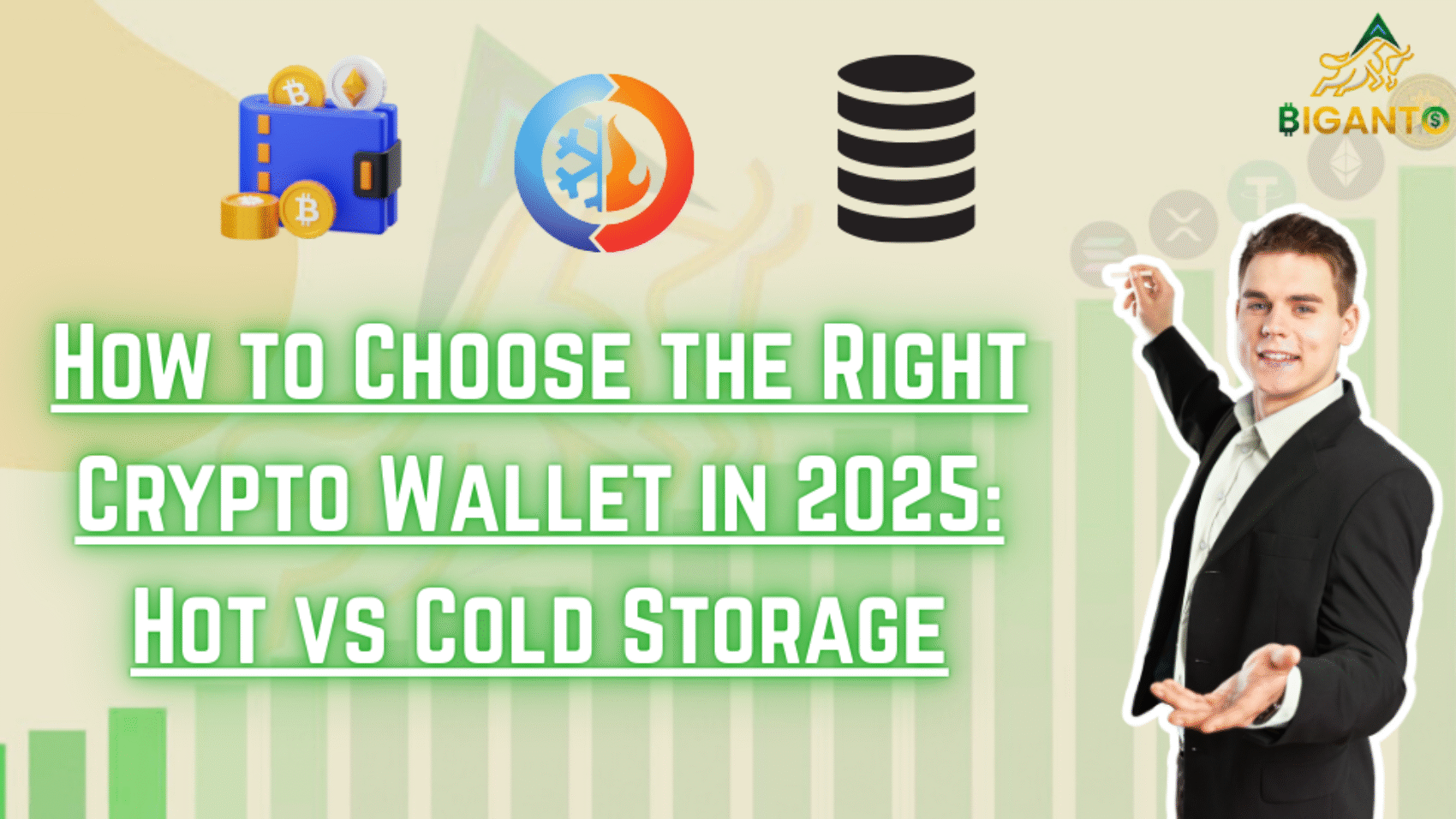Choosing the right crypto wallet is essential for securely storing and managing digital assets. it’s a matter of security, convenience, and strategy. A crypto wallet doesn’t actually hold your coins — it stores your public and private keys, which give you access to your crypto on the blockchain. The public key works like your address, which you can share to receive crypto. The private key is like your secret password that lets you access and control your funds. If someone gets your private key, they can steal your crypto. And if you lose it, there’s no way to recover your money. The wallet also helps you connect to the blockchain so you can send, receive, and manage your crypto. It’s your gateway to using digital assets safely. That’s why protecting your wallet and private key is extremely important in crypto.
What is a Crypto Wallet?
A crypto wallet is a tool that lets you store, send, and receive cryptocurrencies. Unlike a traditional wallet, it doesn’t hold your assets physically—it stores your private keys, which give you access to your digital assets on the blockchain.
Types of crypto wallets
Cryptocurrency wallets can be divided into two main types: hot wallets and cold wallets.
Hot Wallets: Convenience at Your Fingertips - Hot wallets are crypto wallets that stay connected to the internet. You can think of them like a digital wallet on your phone – perfect for quick access and daily use. They’re great for trading, sending, or receiving Bitcoin anytime, anywhere.
These wallets come as apps or browser extensions and are easy to use, which makes them ideal for beginners. But since they’re always online, they’re more at risk from hackers or scams. Still, for small amounts and everyday use, hot wallets are a handy and simple option.
Key Characteristics:
- Online Connectivity: Private keys are stored on devices with internet access (e.g., your smartphone, desktop, or web browser).
- Ease of Use: Generally user-friendly interfaces, making them ideal for beginners.
- Real-time Transactions: Facilitate quick sending, receiving, and swapping of cryptocurrencies.
- Integration with DeFi & NFTs: Many hot wallets offer built-in dApp browsers, allowing seamless interaction with decentralized finance protocols and NFT marketplaces.
- Cost-Effective: Most hot wallets are free to download and use.
Examples of Popular Hot Wallets in 2025:
MetaMask Institutional (MMI) is an advanced version of the popular MetaMask wallet, designed for professional traders and institutions. It offers enhanced security, compliance features, and access to DeFi while allowing teams to manage multiple accounts securely.
Trust Wallet is a beginner-friendly mobile wallet that supports a wide range of cryptocurrencies and blockchains. It’s known for its simple interface, built-in DApp browser, and the ability to stake, swap, and store tokens directly from your phone.
Phantom Wallet is a top choice for the Solana blockchain. It’s a fast, lightweight wallet with a smooth user experience, making it easy to manage SOL, NFTs, and Solana-based tokens while interacting with DeFi apps on the Solana network.
Advantages OF Hot Wallets :
High Convenience: Instant access to your funds for active trading or everyday use.
User-Friendly: Apps and extensions with smooth UI/UX (like MetaMask, Trust Wallet, or Coinbase Wallet).
Free or low-cost: Most hot wallets are free and provide all the basic features you need to get started with Bitcoin without any initial investment.
Disadvantages of Hot Wallets :
Higher Security Risk: Being online makes them more vulnerable to hacking, malware, and phishing attacks.
Reliance on Third Parties: While many are non-custodial (you control your keys), exchange-hosted hot wallets mean you trust the exchange’s security.
Cold Wallets: Best for Long-Term
If keeping your crypto safe is more important than easy access, a cold wallet is the way to go. Unlike hot wallets, cold wallets stay completely offline, which protects them from online threats like hacking or phishing. They’re perfect for holding Bitcoin or other cryptocurrencies for the long term, especially if you don’t need to access your funds often.
There are two main types of cold wallets: hardware wallets and paper wallets. Hardware wallets are small physical devices (like a USB stick) that store your private keys securely offline. They offer strong protection and are widely used by serious investors.
Key Characteristics:
- Offline Storage: Private keys are never exposed to the internet.
- Physical Devices: Typically resemble USB drives or small electronic gadgets.
- Manual Transaction Approval: Require physical interaction (e.g., pressing buttons, entering a PIN) to authorize transactions.
- Higher Upfront Cost: Generally involve a one-time purchase fee for the device.
Examples of Popular Cold Wallets in 2025:
Ledger Nano X is a popular hardware wallet known for its strong security and mobile-friendly features. It comes with Bluetooth support, allowing you to connect it wirelessly to your smartphone through the Ledger Live app. This makes it convenient for managing your crypto on the go while keeping your private keys offline and secure.
Trezor Model T is another top-tier hardware wallet offering a touchscreen interface for easy use and enhanced security. It supports a wide range of cryptocurrencies and allows you to manage your assets safely without exposing your private keys to the internet. Both wallets are ideal for long-term storage and serious crypto investors.
Advantages of Cold Wallet:
- Maximum Security: The most secure way to store cryptocurrencies, offering protection against online threats.
- Control: You have full control over your private keys, reducing the risk of losing your funds if a third-party service is compromised.
- Ideal for Long-Term Holdings: Perfect for “hodling” large amounts of crypto you don’t need immediate access to.
Disadvantages of Cold Wallets :
- Risk of loss: If you lose the hardware wallet or paper wallet and haven’t backed up the recovery phrase, you may lose access to your Bitcoin permanently.
- Upfront Cost: Involves an initial investment for the hardware device.
- Cost: Hardware wallets usually cost ₹6,000 to ₹25,000+.
Key Factors to Consider When Choosing Any Wallet in 2025
Beyond the hot vs. cold debate, here are crucial factors to weigh in 2025:
1. Security Features:
Choose wallets that offer strong security measures like 2-Factor Authentication (2FA), multi-signature support, and a proven safety record. Always check if the wallet has faced past security breaches and how they responded.
2. Supported Cryptocurrencies:
Make sure the wallet supports all the coins and tokens you own or plan to buy. Some wallets are limited to specific blockchains.
3. Ease of Use:
A clean, user-friendly interface makes a big difference—especially if you’re a beginner. Look for wallets that are easy to set up and navigate.
4.Integration with Other Platforms:
Some wallets connect easily with exchanges, DeFi apps, or NFT marketplaces. This can be a huge advantage if you’re an active user.
5. Backup and Recovery:
Understand how to back up your wallet, usually with a seed phrase. Practice recovery steps so you’re prepared in case you lose your device or app access.
Final Thoughts
The world of crypto is constantly evolving, and so too are the wallet solutions available. By carefully considering your individual needs and prioritizing security, you can confidently choose the right crypto wallet in 2025 and safeguard your digital assets for the future. Remember, in the decentralized world, you are your own bank – so choose your wallet wisely.

